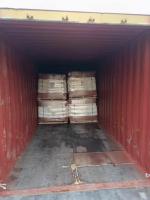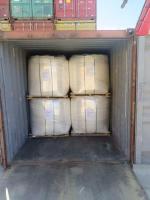Our Products
Polyacrylamide / Nonionic polyacrylamide of Bronte 103 can be replaced byChinafloc N

Nonionic polyacrylamide of Bronte 103 can be replaced byChinafloc N
Bronte 103 is a kind of nonionic polyacrylamide with very lower hydrolysis degree and medium and high molecular weight.mainly used for kinds of mineral processing.
Nonionic polyacrylamide (NPAM) is a highly versatile water-soluble polymer that has found applications in a variety of industries, including water treatment, mining, oil and gas, textiles, and agriculture, to name a few. It is particularly known for its flocculating, thickening, and stabilizing properties, making it an essential tool in processes where separation of solids from liquids is needed. This polymer works differently from its anionic and cationic counterparts, offering advantages in specific environments where those ionic forms may not perform as effectively. Below is a detailed explanation of its primary applications and the mechanism by which nonionic polyacrylamide operates, focusing on its role in diverse industrial sectors.
1. Water Treatment
One of the most prominent applications of nonionic polyacrylamide is in water and wastewater treatment. It is primarily used in coagulation and flocculation processes to remove suspended solids and organic matter from industrial and municipal wastewater. The polymer is effective across a broad range of water conditions, including environments with extreme pH values and high concentrations of salts and organic pollutants, where anionic or cationic polymers might fail.
-
Coagulation and Flocculation: The polymer works by agglomerating small particles, forming larger flocs that can be more easily removed through sedimentation or filtration. In wastewater treatment plants, NPAM is often introduced during the primary clarification phase to help in the removal of organic and inorganic matter. Its ability to perform under different pH conditions makes it particularly useful in industrial applications, such as metal and mineral processing facilities, where wastewater may have a highly acidic or basic composition.
-
Sludge Dewatering: NPAM is also used in sludge dewatering, helping to separate water from sludge in wastewater treatment plants. By forming larger flocs, the polymer enables more efficient mechanical dewatering techniques, such as centrifugation or filtration, resulting in drier sludge and reduced disposal costs.
2. Mining Industry
In the mining sector, nonionic polyacrylamide plays a key role in solid-liquid separation processes. Mining operations generate a significant amount of wastewater containing fine particles and minerals that must be separated before disposal or reuse.
-
Thickening: In mineral processing, NPAM is used in thickeners to concentrate valuable minerals from ores. The polymer enhances the settling of fine particles by promoting the formation of larger, heavier flocs that settle more quickly at the bottom of the thickening tank. This allows for the more efficient recovery of water, which can then be recycled back into the mining process, reducing the need for fresh water and minimizing environmental impact.
-
Filtration: After the thickening stage, NPAM may be used in filtration processes to further separate solid particles from liquid. This helps improve the clarity of the filtrate and enhances the recovery of minerals.
3. Oil Extraction
Nonionic polyacrylamide is also employed in the oil and gas industry, where it serves as a valuable additive in drilling fluids and enhanced oil recovery techniques.
-
Drilling Fluids: During drilling operations, NPAM is added to water-based drilling fluids to increase their viscosity. This helps in stabilizing the borehole, carrying drill cuttings to the surface, and preventing the collapse of the well. The polymer’s nonionic nature makes it compatible with a wide range of geological formations, including those with high salinity or varying pH conditions, where other types of polymers may degrade or lose effectiveness.
-
Enhanced Oil Recovery: In tertiary oil recovery processes, also known as enhanced oil recovery (EOR), nonionic polyacrylamide is injected into the oil reservoir to improve the displacement of oil. The polymer increases the viscosity of the injected water, allowing it to push more oil towards the production wells, thereby improving overall recovery rates. This application is particularly beneficial in aging oil fields where traditional recovery methods are no longer effective.
4. Textile Industry
Nonionic polyacrylamide has a variety of applications in the textile industry, particularly in the production of fabric and dyeing processes.
-
Textile Sizing: NPAM is used as a sizing agent to coat the fibers before weaving, which helps in reducing breakage during the manufacturing process. It strengthens the fibers, reducing friction, and minimizing damage, leading to more efficient weaving operations.
-
Dye Fixation: In dyeing processes, nonionic polyacrylamide enhances the bonding of dyes to the fibers, resulting in brighter and more durable colors. The polymer helps in improving the adsorption of dyes, particularly under conditions where the dye may not easily bind to the fabric.
5. Papermaking
The papermaking industry relies heavily on NPAM for its flocculating properties to improve the efficiency of fiber retention, drainage, and paper formation.
-
Retention and Drainage Aid: NPAM is used to retain fine particles and fibers during the papermaking process. It promotes the retention of fillers and fibers on the paper machine wire, which helps to improve paper quality while reducing material loss. In addition, NPAM enhances the drainage of water from the paper sheet, accelerating the drying process and increasing production efficiency.
-
Improved Paper Strength: The use of NPAM can improve the mechanical properties of paper by enhancing fiber bonding. This results in stronger, higher-quality paper products.
6. Soil Stabilization and Erosion Control
In agriculture and land reclamation projects, nonionic polyacrylamide is used for soil stabilization and erosion control. Its ability to bind soil particles together helps in improving soil structure, reducing erosion caused by water or wind, and promoting water infiltration.
-
Soil Aggregation: NPAM promotes the formation of soil aggregates by binding fine soil particles together. This improves soil porosity, water retention, and root penetration, enhancing plant growth and reducing the risk of soil erosion, particularly in areas prone to heavy rainfall or irrigation.
-
Erosion Control: The polymer is often applied to disturbed or exposed soil surfaces to prevent erosion. By forming a protective layer, it helps in minimizing soil loss during construction or landscaping projects.
7. Food Processing
Nonionic polyacrylamide also finds use in the food processing industry, particularly in applications where the separation of solids and liquids is required.
-
Clarification of Juices and Beverages: NPAM is used in the clarification of fruit juices and beverages. It helps in the removal of suspended particles and organic matter, improving the clarity and stability of the final product.
-
Wastewater Treatment: In food processing facilities, NPAM is employed to treat wastewater generated during operations such as washing, processing, and cleaning. It aids in the removal of organic and inorganic contaminants from the water, ensuring that it can be safely discharged or reused.
The functionality of nonionic polyacrylamide stems from its ability to form hydrogen bonds with suspended particles in water or soil. Unlike anionic or cationic polyacrylamides, which rely on electrostatic charges to attract oppositely charged particles, NPAM is nonionic, meaning it does not carry an electrical charge. This neutral characteristic makes it highly effective in situations where ionic polymers may be less efficient or even counterproductive, such as in environments with high salinity or extreme pH levels.
-
Flocculation Process: The polymer’s long-chain molecular structure allows it to bridge between small particles in suspension, bringing them together to form larger aggregates, or flocs. These larger flocs can then settle out of suspension more easily, allowing for their removal through sedimentation or filtration. This flocculation process is particularly useful in water treatment, mining, and papermaking.
-
Thickening: In applications such as enhanced oil recovery or drilling fluids, NPAM acts as a thickening agent. By increasing the viscosity of water or other fluids, the polymer helps in stabilizing the flow, reducing the loss of fluid to surrounding formations, and improving the efficiency of the extraction process.
-
Stabilization: In soil stabilization and erosion control, NPAM works by binding fine soil particles together, improving soil structure and resistance to erosion. This not only protects the soil but also enhances its water retention capacity and promotes better plant growth.



495_small.jpg)

356_small.jpg)